The French Biodiversity Data Hub (“Pôle National de Données de Biodiversité” – PNDB) has led the French participation to GEO BON since 2015 (through the Ecoscope initiative) and recently shared the lead with public policies information system coordination (“Système d’Information sur la Biodiversité” – SIB). Thanks to this co-lead, this national BON proposes a concerted coordination of all biodiversity data and metadata from monitoring programs, from expertise to research around an innovative Essential Biodiversity Variable (EBV) operationalization pilot (basis of EBVOSC case study proposal). This pilot is made of open practical solutions providing a particular high degree of FAIRness (Findable, Accessible, Interoperable, Reusable) of biodiversity digital objects, from raw data to indicators through source codes. The French BON is linked to the French Global Biodiversity Information Facility (GBIF) node.

Understand, share and use biodiversity {meta}data, from genes to socio-ecosystems, from Research to Public Policies.
What is the PNDB ?

The PNDB is a national e-infrastructure created in 2018 and led by the National Museum of Natural History with support of 18 others partners (see below partners section). It contributes to the Open Science policy of the Ministry of Higher Education, and Research (MESR).
Based on the FAIR principles, PNDB offers support and facilitation for the understanding, sharing and using of biodiversity data by scientific communities. It offers services and adapted tools based on existing technologies throughout the data cycle, from the contribution to development of data management plans, to the production of indicators, through data paper publication (eg. catalog of metadata for a project, application to generate and share metadata, analysis platform, summer schools, data access, training, guidance).
Thanks to its nomination in 2022 as a thematic reference center of the MESR, PNDB will contribute to promoting the FAIR princples, to increase the skills of the scientific communities around open science and stimulate interactions between producers and users of biodiversity data. PNDB is also a major European point of contact for the DataOnenetwork, and it will be integrated as the fifth pole of the national research infrastructure Data Terra.
What is the SIB ?

The Biodiversity Information System ( “Système d’Information sur la Biodiversité“ – SIB) is the platform which aims to federate all available and usable biodiversity data from Public Policies in France, in order to improve their accessibility and reuse. For this, it offers methods, protocols and services for the production and sharing of this data for more than 30 public policies related to biodiversity (e.g. N2000, CITES), so that they separate their data relating to
- its state: the occurrence, distribution or even the conservation status of animal, plant and fungal species, habitats and environments,
- the pressures and threats exerted on it,
- the actions necessary for its preservation and restoration.
The SIB will also be the basis for terrestrial biodiversity monitoring data access: setting up “a long-term biodiversity monitoring network”, in link to one of the european co-funded partnership Biodiversa+ program. This terrestrial biodiversity monitoring should provide a regular and precise view of the state of biodiversity, in connection with the national biodiversity strategy SNB 2030 which constitutes the French version of the objectives of the Convention on Biological Diversity (COP15).
About French BONCo-Leads
 Yvan Le Bras
Yvan Le BrasNational Museum of Natural History (MNHN)
 Jean-Denis Vigne
Jean-Denis VigneNational Museum of Natural History (MNHN)
Coordination Committee
 Sandrine Pavoine
Sandrine PavoineNational Museum of Natural History (MNHN)
 Olivier Norvez
Olivier NorvezFrench Foundation for Biodiversity Research (FRB) & National Museum of Natural History (MNHN)
| Interested to join? Click the Register button. |
To reach the overall goal (i.e. to contribute to document the state and to understand the trends of the biodiversity), the French BON addresses 3 key objectives leading to actions:
Key objectives
- To facilitate access and data sharing, to promote services for researchers and products for policy makers. The strategy adopted is to incubate a metadata portal as it is impossible to gather, in a single database, all biodiversity data covering all the biodiversity organization level and to co-develop services based on expertise from researchers.
- To encourage the complementarity of observation through all the levels of life organization (not only the species level) and through a holistic approach, allowing actors to join forces while respecting aims and constraints of each. The strategy adopted is to use the EBV concept in conjunction with wildlife experts, policy makers, and researchers from other fields (abiotic, socio-economic aspects, etc.) to propose an operational framework.
- To promote collaboration with national and international existing initiatives. The strategy adopted is to identify and/or develop collaborations with biodiversity data producers and users’ initiatives, with other data hubs dedicated to ocean, Earth’s surfaces, atmosphere and solid Earth to promote their actions and best practices for data management.
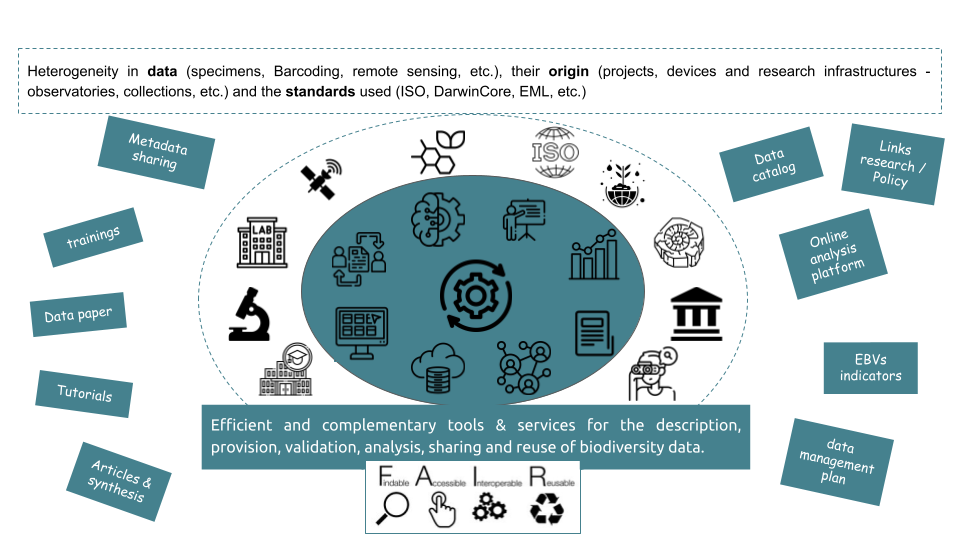
1. Provide access to metadata and biodiversity observations datasets, to services and tools for visualizing and analysing data
| Leads |
From FRB [2017] to the PNDB [2018] to the French BON (PNDB + SIB) [2021] with high-level information system capabilities.
|
|||
| Team/Partners |
PNDB team + PNDB partners + SIB team + SIB partners
|
|||
| EBV Class |
from genes to socio-ecosystems
|
|||
| Development approach |
Capacity Building, Biodiversity Data, Algorithms / source codes & metadata Collection (from Research and Public Policies)
|
|||
| Description |
Data integration in biodiversity science is complex, essentially because a federated framework harmonizing data and methods is lacking. Getting interoperable data from raw, heterogeneous and scattered datasets to measure and understand the spatio-temporal dynamics of biodiversity from local to global scales is both necessary and challenging. Essential Biodiversity Variables (EBVs) represent a relevant framework for identifying appropriate data to be collated and for creating and implementing analytical workflows, from raw data to EBV data products. Our aim is to operationalize EBV indicators by targeting the highest levels of FAIRness (Findable, Accessible, Interoperability, Reusable) for both data and source code implementation, so that data and tools can be widely shared and reused. A number of open standards, tools, platforms used by international infrastructures. In particular, we are already engaged with the Galaxy platforminitiative for source code management and use; the DataOne network of data catalogs; the Ecological Metadata Language standard for data management; the 2021-2023 BiodiFAIRse GO FAIR IN roadmap; and GEO BON’s roadmap (“Improve the acquisition, coordination and delivery of biodiversity observations and related services to users including decision makers and the scientific community”). In relation with the GOSC vision, EBVOSC will seek to utilize, contribute to and ensure interoperability with these initiatives. |
|||
| Timeline | 2020 | 2021 | 2022 | 2023 |
| Milestones and/or Deliverables |
Producing first EBV workflows using Galaxy-E to addressee species populations and community compositions EBV Classes
|
Producing new EBV workflows for Genetic composition and community composition EBV Classes Finalize conceptual use of detailed EML metadata to describe raw and derived EBV datasets |
Integration of previous work in global initiatives: GO FAIR BiodiFAIRse Implementation network and Global Open Science Cloud (GOSC) through “EBVOSC” case study creation
|
Developing interoperability with other national and international information systems (via the EML (for data/metadata) and Galaxy (for source codes) notably through “EBVOSC” GOSC case study)
|
| Resources |
cf. “document and publications” section
|
|||
| Link with other activities |
This activity will collaborate with the BON Development WG, particularly with BON in a Box (BD2). The activity is also strongly linked with activities of GBIF-France.
|
|||
2. Encourage joint and integrated approach to develop the complementarity of observations
|
From FRB [2017] to the PNDB [2018] to the French BON (PNDB + SIB) [2021] with high-level information system capabilities.
|
||||
| Team/Partners |
PNDB team + PNDB partners + SIB team + SIB partners
|
|||
| EBV Class |
from genes to socio-ecosystems
|
|||
| Development approach |
Capacity Building, Monitoring Protocol design, Assessments and Policy Support, events (as thematic schools & hackathons)
|
|||
| Description |
Integration of biological data with different ecological scales is complex! The biodiversity community (scientists, policy makers, managers, citizen, NGOs) needs to build a framework of harmonized and interoperable data from raw, heterogeneous and scattered datasets. Following this, The French BON will
Lead an EBV operationalization pilot who will not only focus on “IT” (data/source codes) challenges but also allows to 1/ help national BON development notably helping “production and reuse of peer-reviewed EBV workflows and related protocols” 2/ have an exhaustive vision of monitoring programs to help identify gaps and complementarity of approaches |
|||
| Timeline | 2020 | 2021 | 2022 | 2023 |
| Milestones and/or Deliverables |
Producing first EBV workflows using Galaxy-E to addressee species populations and community compositions EBV Classes
|
Producing new EBV workflows for Genetic composition and community composition EBV Classes Finalize conceptual use of detailed EML metadata to describe raw and derived EBV datasets |
Integration of previous work in global initiatives: GO FAIR BiodiFAIRse Implementation network and Global Open Science Cloud (GOSC) through “EBVOSC” case study creation Launch of the national project Gaia Data where the PNDB is involved with two others research infrastructure Data Terra and Climeri
|
Joint event (summer-camp) co-organized by the SIB and PNDB Developing interoperability with other national and international information systems through GO FAIR and GOSC |
| Resources |
cf. “document and publications” section
|
|||
| Link with other activities |
This activity will collaborate with the BON Development WG, particularly with BON in a Box (BD2) and relevant GEO BON task Forces.
|
|||
3. Contribution to national and international initiatives and openness
|
PNDB team
|
||||
| Team/Partners |
National initiatives working on data management and/or involved in international initiatives.
|
|||
| EBV Class |
from genes to socio-ecosystems
|
|||
| Development approach |
Case study, events, workshops + capacity building
|
|||
| Description |
Recherche Data Gouv : As a thematic reference center and research infrastructure of the Ministry of Research and Higher Education (via the PNDB), the French BON Informs & trains communities on:
GO FAIR: (FAIRness not directly related to openness, but our vision, in the BiodiFAIrse implementation Network is to combine FAIRness and Openness) GOSC and EOSC: (Active participation on several European Open Science Cloud projects like H2020 EOSC-Pillar, HORIZON EUROPE FAIR-EASE and HORIZON EUROPE EURO SCIENCE GATEWAY). BOLD : PNDB is national node of BOLD promoting sharing open data and metadata of DNA DataONE: PNDB is national node of DataONE promoting sharing open data and metadata EML: PNDB is contributing to the NCEAS and EDI development of EML oriented initiatives like EML Assembly Line R package and related to MetaShARK R Shiny app.interface. Galaxy: PNDB is coordinating the “Galaxy for Ecology” international initiative to allow better access, transparency and reproducibility of open source codes in Ecology.
|
|||
| Timeline | 2020 | 2021 | 2022 | 2023 |
| Milestones and/or Deliverables |
PNDB involved in ERASMUS+ “Gallantries” European project PNDB is leading BiodiFAIRse GO FAIR initiative |
PNDB officially the french node of Data Observation Network for Earth (DataONE) https://www.dataone.org/ |
The PNDB is a thematic reference center (Ministry of Higher education and Research) via Recherche data Gouv. PNDB involved in FAIR-EASE and EuroscienceGateway Horizon Europe projects, linked to the European Open Science Cloud (EOSC) initiative. The PNDB proposes the FAIR Implementation Profiles framework to create a national cartography of Biodiversity informations systems |
Developing a pedagogic website for understanding FAIR principles Fair Implementation Profiles Developing interoperability with other national and international information systems through GO FAIR and GOSC |
| Resources |
cf. “document and publications” section
|
|||
| Link with other activities |
This activity will collaborate with the BON Development WG, and relevant GEO BON task Forces
|
|||
PNDB data products
The PNDB structures its tools along three main axes, which are “understanding data and metadata”, “sharing them”, and “using them”.
Understand biodiversity data & metadata
As a thematic reference center and research infrastructure of the Ministry of Research and Higher Education, the PNDB Informs & trains communities on:
- the issues around biodiversity {meta}data,
- the French and international landscape of information systems and their link with the PNDB,
- the FAIR principles (Easy to find, Accessible, Interoperable, and Reusable),
- the pivot standard EML (Ecological Metadata Language) for the detailed description of metadata.
- tools
- ○ MetaShARK (Metadata Shiny Application for Resources and Knowledge) for sharing {Meta}data,
- ○ Metacat catalog for finding and using {meta}data
- ○ and Galaxy-Ecology for using & analyzing data, and sharing source codes.
- services (“FAIRisation” and provision of data and source codes, training/hackathons, …

Share biodiversity data & metadata
Fill in the metadata and share it using The Ecological Metadata Language – EML – allows :
- making connections between people, projects, objects (data, source code, protocols, …), research themes
- integrating and generating metadata linked to other information systems, institutional repositories
- generating V0 of data papers

Use biodiversity data & metadata
A Catalog (Metacat/Metacatui) to access datasets via a fine description of metadata and could generate FAIR assessment report
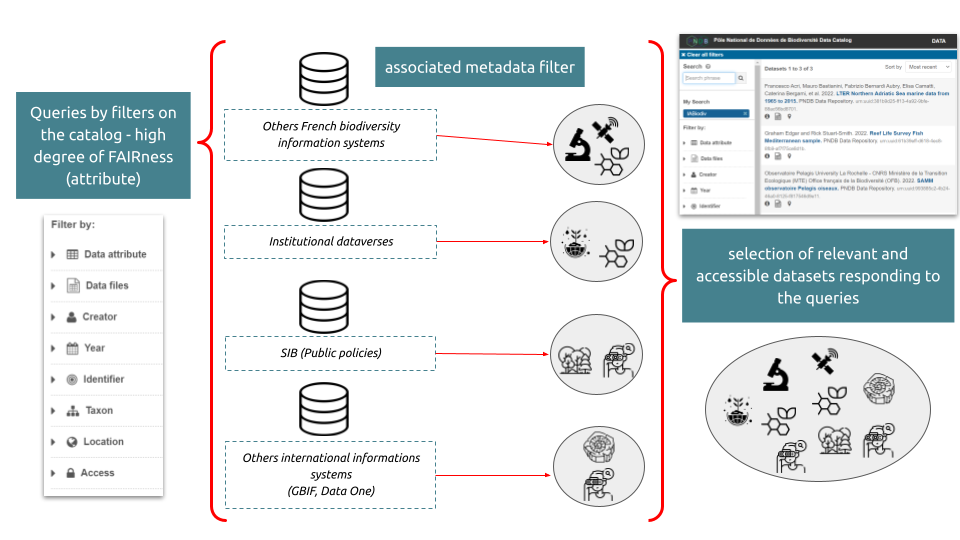
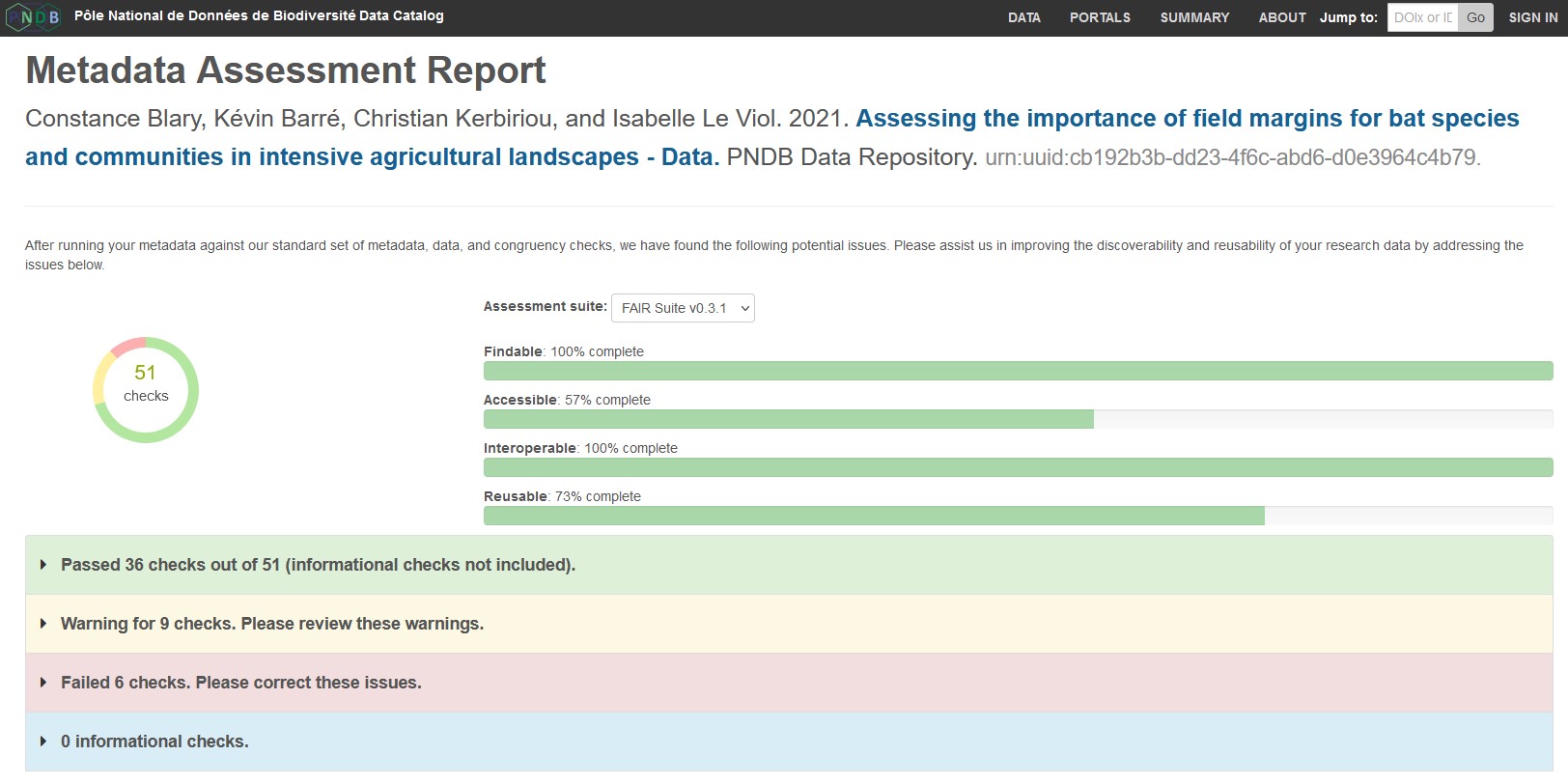
An online analysis platform (Galaxy-Ecology). See the tutorials for discovering this tool
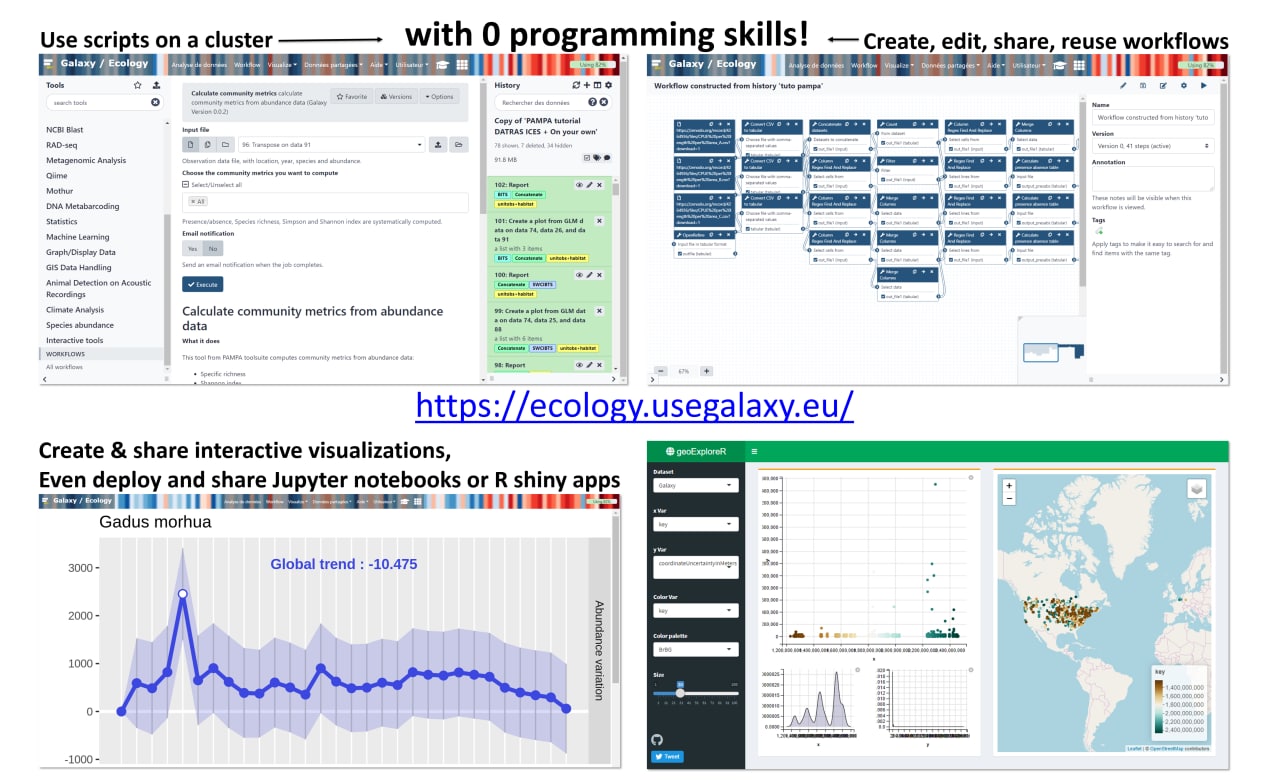
SIB data products
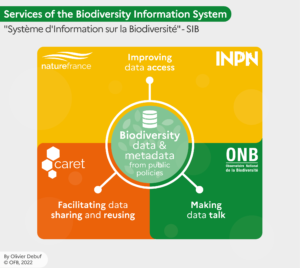
Improving data access:
- Naturefrance portal to the SIB “ecosystem”, linked with the SIE (for limnological data) and the SIMM (for marine data) Catalogs
- The SIB catalog : being fed by public policy data: DPSIR (linked to INPN and OpenOBs : 120 M occurrence data)

Facilitating data sharing and reusing
The SIB provides reference data : national references (taxref / Habref) in connection with international repositories to allow the interoperability of data produced in different contexts. For example, in the catalog, we can find some information from :/ SINP / GBIF fr
Make the data speak
The national biodiversity observatory (“Observatoire national de la Biodiversité” – ONB) develops indicators reflecting the major issues identified by the national biodiversity strategy or reflecting issues relating to specific environments or themes. They are based on a wide variety of data sources (see the indicator sheets), a large part of which is accessible through the SIB.
Reports
- Delavaud A. et al. État des lieux et analyse des paysages des observatoires français de recherche sur la biodiversité. Expertise and summary of the Foundation for Research on Biodiversity. Available online at www.fondationbiodiversite.fr/etat-des-lieux-et-analyse-des-paysages-des-observatoires-francais-de-recherche-sur-la-biodiversite/
- Mahé S., Marlin C. et al. 2020 Livre Blanc sur les infrastructures françaises de recherche du domaine des sciences du système Terre et de l’environnement – Vision stratégique d’AllEnvi 2020-2030. Paris, France : AllEnvi, 116 p. Available online at https://www.allenvi.fr/wp-content/uploads/2022/06/Livre_blanc_Infrastructures_2020-2030.pdf
- Ministère de l’Ensignement Supérieur et de la Recherche. 2022. Feuille de route nationale des infrastructures de recherche. Available online at https://www.enseignementsup-recherche.gouv.fr/sites/default/files/2022-03/feuille-de-route-nationale-des-infrastructures-de-recherche—2021-v2–17318.pdf
- Observatoire National de la Biodiversité – ONB. 2021. Bilan 2021. 8 p. Available online at https://naturefrance.fr/sites/default/files/2021-10/PublicationONB_2021_VF.PDF
- Système d’Information sur la Biodiversité. 2021. 34p. The SIB roadmap (2021-2023). 34 p. Available online at https://naturefrance.fr/publications/la-feuille-de-route-sib
Scientific communications (selection)
- Michel F, Gargominy O, Tercerie S, & Faron Zucker C. A Model to Represent Nomenclatural and Taxonomic Information as Linked Data (2017). Application to the French Taxonomic Register, TAXREF. ISWC 2017 Workshop on Semantics for Biodiversity (S4Biodiv 2017), Oct 2017, Vienna, Austria. pp.1-12. hal-01617708 Avaible online at https://hal.archives-ouvertes.fr/hal-01617708/document
- Le Bras Y, Archambeau A-S (2019) BiodiFAIRse: a Biodiversity dedicated GO FAIR Implementation Network. Biodiversity Information Science and Standards 3: e35369. https://doi.org/10.3897/biss.3.35369
- Le Bras Y, Delavaud A, Pelletier D, Mihoub J-B (2019) From Raw Biodiversity Data to Indicators, Boosting Products Creation, Integration and Dissemination: French BON FAIR initiatives and related informatics solutions. Biodiversity Information Science and Standards 3: e39215. https://doi.org/10.3897/biss.3.39215
- Le Bras Y, Poncet L, Vigne J-D (2019) Towards a French National Biodiversity Virtual Research Environment. Biodiversity Information Science and Standards 3: e39216. https://doi.org/10.3897/biss.3.39216
- Royaux C, Arnaud E, Sananikone J, Jossé M, Madelin M, Pelletier D, Norvez O, Le Bras Y (2022) Open Science for Better FAIRness: A biodiversity virtual research environment point of view. Biodiversity Information Science and Standards 6: e95110. https://doi.org/10.3897/biss.6.95110
- Royaux C, Norvez O, Jossé M, Arnaud E, Sananikone J, Pavoine S, Pelletier D, Mihoub J-B, Le Bras Y (2022) From Biodiversity Observation Networks to Datasets and Workflows Supporting Biodiversity Indicators, a French Biodiversity Observation Network (BON) Essential Biodiversity Variables (EBV) Operationalization Pilot using Galaxy and Ecological Metadata Language. Biodiversity Information Science and Standards 6: e94957. https://doi.org/10.3897/biss.6.94957
- Royaux C, Sananikone J, Arnaud E, Norvez O, Ainsa A, Morin S, Pamerlon S, Archambeau A-S, Le Bras Y (2022) French Biodiversity Data Hub: Linking local to global biodiversity through international initiatives and open science clouds. Biodiversity Information Science and Standards 6: e91374. https://doi.org/10.3897/biss.6.91374
- Sananikone J, Arnaud E, Norvez O, Pamerlon S, Archambeau A-S, Le Bras Y (2022) From Raw Data to Data Standards through Quality Assessment and Semantic Annotation. Biodiversity Information Science and Standards 6: e91205. https://doi.org/10.3897/biss.6.91205
External references inspiring the French BON framework
- Costello M.J. et al., 2013. Biodiversity data should be published, cited, and peer reviewed. Trends in Ecology and Evolution. https://doi.org/10.1016/j.tree.2013.05.002
- Goecks, J., Nekrutenko, A., Taylor, J. et al. Galaxy : a comprehensive approach for supporting accessible, reproducible, and transparent computational research in the life sciences. Genome Biol 11, R86 (2010).https://doi.org/10.1186/gb-2010-11-8-r86 And 2021 update : https://doi.org/10.1093/nar/gkac247
- Grüning B, Chilton J, Köster J, Dale R, Soranzo N, van den Beek M, Goecks J, Backofen R, Nekrutenko A, Taylor J. Practical Computational Reproducibility in the Life Sciences. Cell Syst. 2018 Jun 27;6(6):631-635. doi: 10.1016/j.cels.2018.03.014. PMID: 29953862; PMCID: PMC6263957. https://doi.org/10.1016/j.cels.2018.03.014
- Hardisty A. and Roberts D. 2013 A decadal view of biodiversity informatics: challenges and priorities. BMC Ecology https://doi.org/10.1186/1472-6785-13-16
- Hardisty A. et al., 2019 The Bari Manifesto: An interoperability framework for essential biodiversity variables. Ecological Informatics https://doi.org/10.1016/j.ecoinf.2018.11.003
- Jones M.B. et al., 2006 The New Bioinformatics: Integrating Ecological Data from the Gene to the Biosphere. Annual review in Ecology, Evolution and Systematics.https://doi.org/10.1146/annurev.ecolsys.37.091305.110031
- Kissling W.D. et al., Building essential biodiversity variables (EBVs) of species distribution and abundance at a global scale Biological Reviews https://doi.org/10.1111/brv.12359
- König C. et al., Biodiversity data integration—the significance of data resolution and domain. PLOS Biology. https://doi.org/10.1371/journal.pbio.3000183
- Magagna, B, et al. 2020. Reusable FAIR Implementation Profiles as Accelerators of FAIR Convergence.Advances in conceptual modeling. https://link.springer.com/chapter/10.1007/978-3-030-65847-2_13
- Michener W.K. et al., 1997 Non geospatial metadata for ecological sciences. Ecological Applications.https://doi.org/10.1890/1051-0761(1997)007[0330:NMFTES]2.0.CO;2
- Michener W.K. and Jones M.B. 2012 Ecoinformatics: supporting ecology as a data-intensive science. Trends in Ecology and Evolution https://doi.org/10.1016/j.tree.2011.11.016
- Michener W.K. et al., 2015 Ten Simple Rules for Creating a Good Data Management Plan. PLOS Computational Biology https://doi.org/10.1371/journal.pcbi.1004525
- Page R. 2016 Towards a biodiversity knowledge graph. Research Ideas and Outcomeshttps://doi.org/10.3897/rio.2.e8767
- Peterson A.T. et al., 2015 A global perspective on decadal challenges and priorities in biodiversity informatics BMC Ecology https://doi.org/10.1186/s12898-015-0046-8
- Poisot T. et al., 2019 Ecological Data Should Not Be So Hard to Find and Reuse. Trends in Ecology and Evolution. https://doi.org/10.1016/j.tree.2019.04.005
- Powers S.M. & Hampton S.E., 2018. Open science, reproducibility, and transparency in ecology.https://doi.org/10.1002/eap.1822
- Rilling M.C. et al., 2015 Biodiversity Research: data without theories – theories without data. Frontiers in Ecology and Evolution https://doi.org/10.3389/fevo.2015.00020
- Urban M.C. et al., 2021 Designing a Platform for Projecting and Protecting Global Biodiversity. BioSciencehttps://doi.org/10.1093/biosci/biab099
Communication support
- PNDB poster :
- SIB brochure (in French) https://ged.ofb.fr/share/s/uctLpxJbQ76aTZV2UpGkBA
- websites (in French, available soon in english too)
PNDB https://www.pndb.fr/
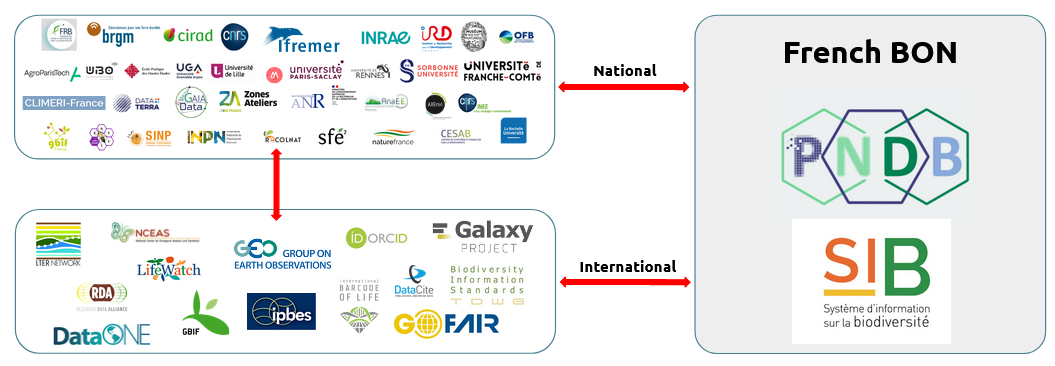
For the PNDB :
The PNDB is an integrated and integrative research infrastructure made up of 19 partners and with scientific and technical support by the National Museum of Natural History via PatriNat (OFB-CNRS-MNHN) co-support of the animation by the Foundation for Research on Biodiversity (FRB). The other partner members of the PNDB are: BRGM, CIRAD, CNRS, Ifremer, INRAE, IRD, OFB, AgroParisTech, University of Western Brittany, École Pratique des Hautes Etudes, Grenoble Alpes University, Lille University, Paris-Saclay University, Montpellier University, Rennes University, Sorbonne University, and Franche-Comté University

For the SIB :
The SIB was officially created following the promulgation of the law of August 8, 2016 for the recovery of biodiversity, nature and landscapes. The ministry in charge of the environment has entrusted its coordination and technical coordination to the French Office for Biodiversity (OFB), and more particularly the PatriNat service (OFB-CNRS-MNHN).

- PNDB website https://www.pndb.fr/en/
- SIB website https://naturefrance.fr/systeme-information-biodiversite
- EBVOSC project (submitted to GOSC): From raw biodiversity data to operational indicators through the Essential Biodiversity Variables https://www.pndb.fr/fr/activites/projets-techniques-et-scientifiques/ebvosc
- EBVs data portal (work in progress) made by the PNDB team and collaborators : https://data.pndb.fr/portals/FrenchEBVDataPortalfr
- Galaxy-Ecology Trainings https://training.galaxyproject.org/training-material/topics/ecology/

